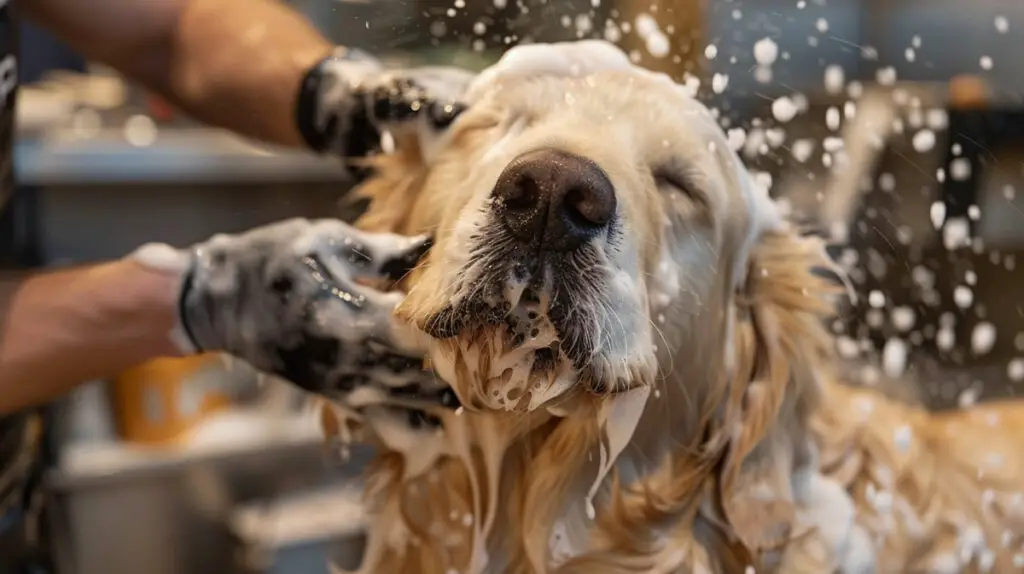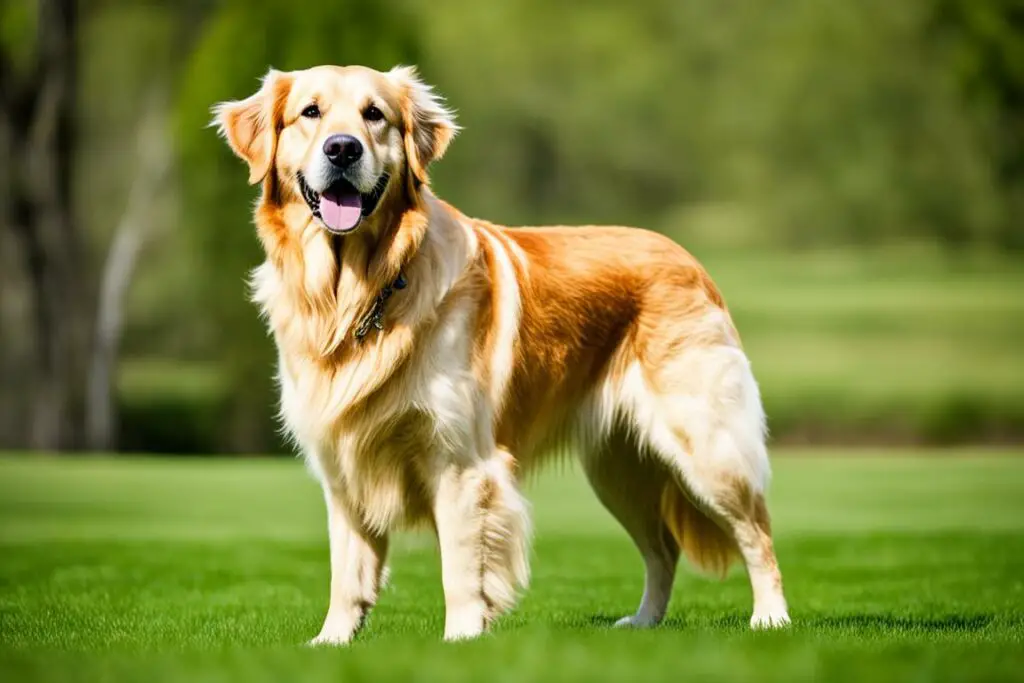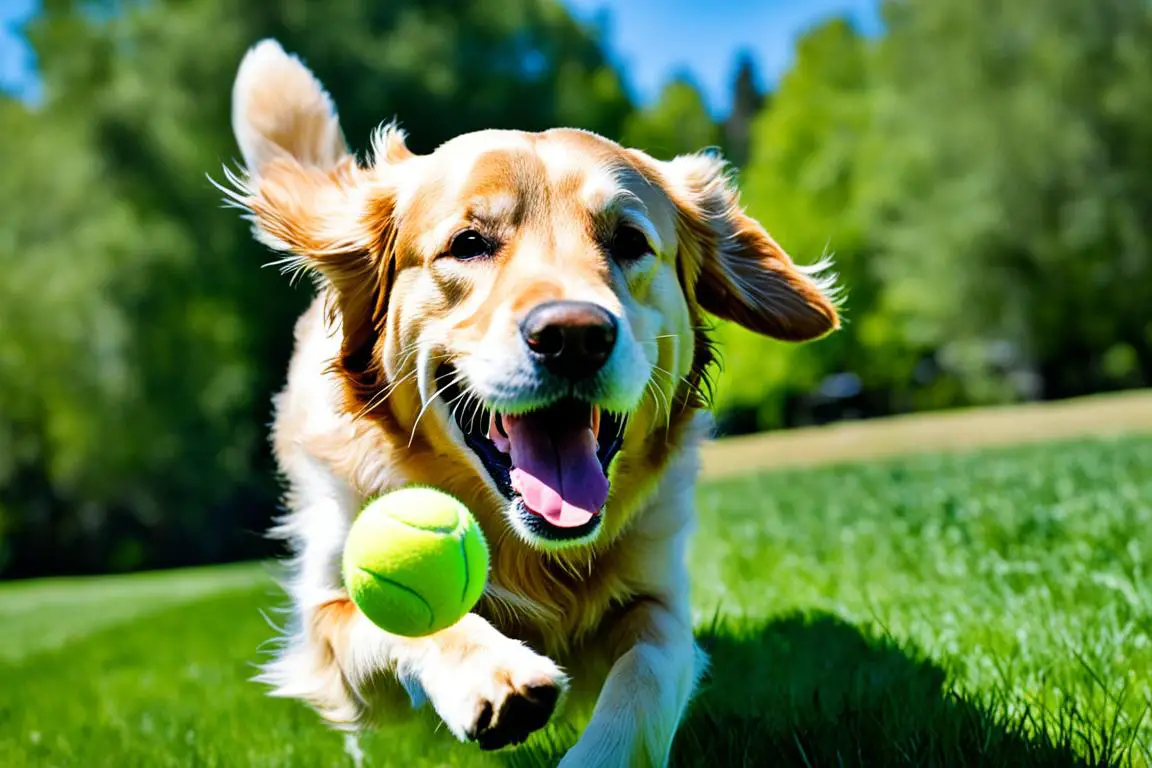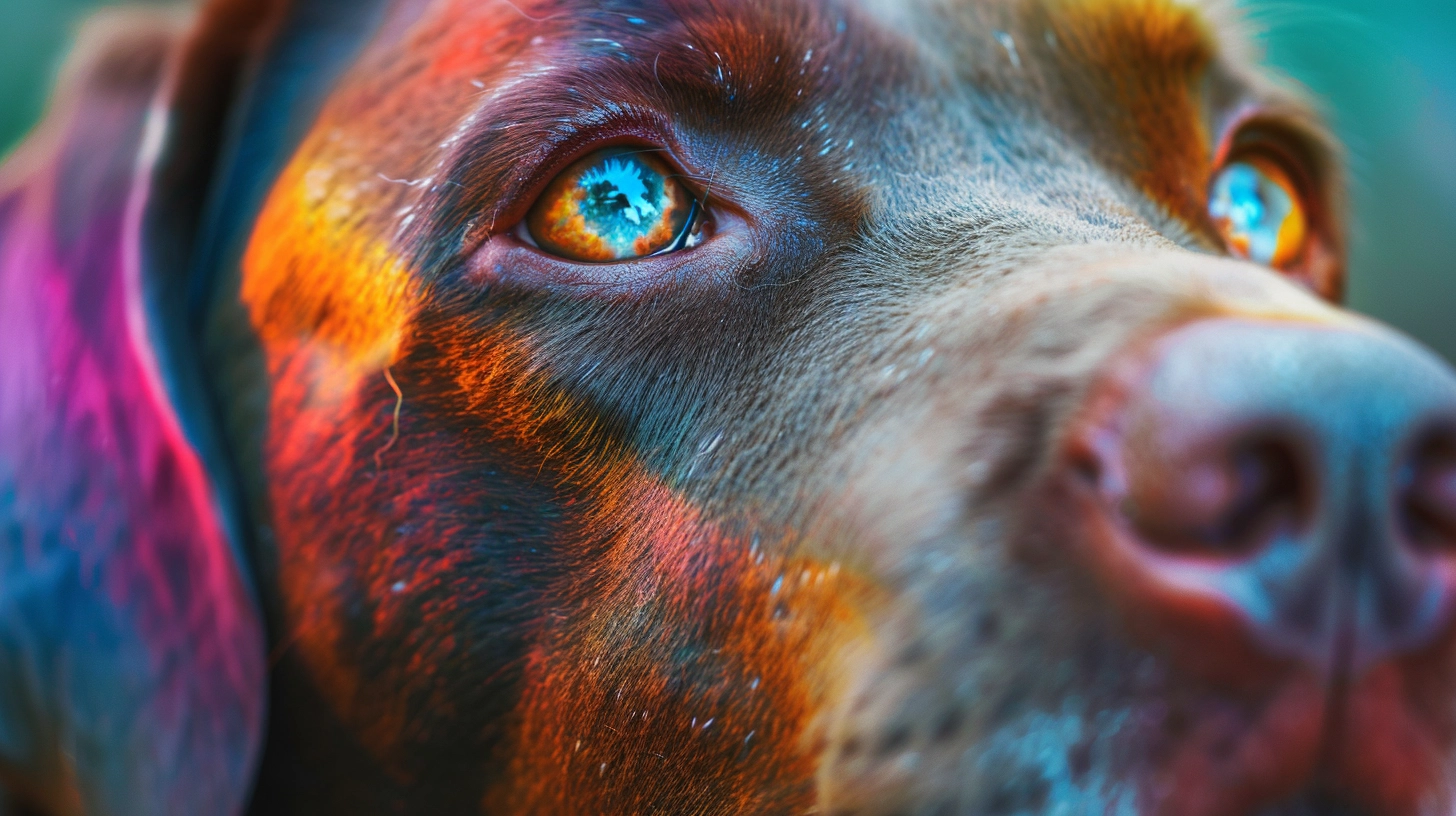Golden Retrievers rank among the top dog breeds in the US. Their smart, friendly, and versatile traits make them perfect family pets. They’re not just loving companions but also skilled retrievers.
Key Takeaways:
- Golden Retrievers are a popular dog breed, known for their intelligence, friendly nature, and versatility.
- They make excellent family pets and are loyal companions.
- Golden Retrievers are highly trainable and excel in various activities, including retrieving, agility, and therapy work.
- Their friendly and sociable nature makes them great with children and other pets.
- Proper care and training are essential to raise a well-behaved and happy Golden Retriever.
Puppy Training from the Start
Bringing a Golden Retriever puppy home means beginning their training early. Training early does more than teach obedience. It also forges a strong bond. To give your puppy a great start, follow these important steps:
- Choose a Reputable Breeder: Pick a reputable breeder for a healthy Golden Retriever puppy. This choice helps your puppy begin life well and reduces future health risks.
- Group-Based Training: Put your puppy in group Puppy Kindergarten and basic classes. They learn to socialize and obey in these classes. Plus, their physical, social, and mental needs are met.
- Building Obedience Skills: Teach basic commands like sit, stay, come, and heel early on. Be consistent and use positive reinforcement to build strong obedience skills.
“Training a Golden Retriever puppy from the start ensures a well-behaved companion and a lifelong bond.”
Training is more than just obedience; it also keeps their minds active and stops bad behavior. During this key time, let your puppy experience different places, sounds, and people. This builds their confidence and helps them adapt well.
By focusing on training and positive reinforcement, you are helping your Golden Retriever puppy become a well-behaved and happy adult dog.
Developmental and Fear Stages
Golden Retriever puppies grow and change a lot as they get older. It’s really important to understand these changes. This helps you care for and train your dog better. Around 8 to 14 weeks old, they hit a fear stage. They might get scared easily by new things, people, or places. During this time, it’s up to the owner to make them feel safe and help them get through it.
It’s very important to let your puppy experience new things. This can stop them from being too scared later on. Letting them hear different sounds, see different sights, and be in new places builds their confidence. Doing this slowly and making sure they’re not scared is key to helping them grow strong.
“Proper socialization and exposure to new experiences at an early age are crucial for preventing fear behaviors in Golden Retriever puppies.”
When your puppy is going through the fear stage, pay attention to how they act. Knowing what their actions mean can show you when they’re not feeling brave. Giving them comfort and telling them it’s okay can really help. This way, they learn to trust you and not be so scared.
Helping your puppy get used to the world involves meeting different people and animals. It also means going to various places. Start with things that are okay for their age. Then, you can try more complex things little by little. This helps them learn to deal with new situations well.
It’s all about introducing new things in a good way. Start slow and watch how your puppy reacts. By creating a world of positive experiences and slowly upping the challenge, you help them learn to handle anything confidently.
Establishing Routines and Boundaries
Golden Retriever care needs schedules, routines, rules, and boundaries. These provide structure and stability. With clear expectations and a consistent environment, your puppy’s happiness and well-being are ensured.
Make a daily schedule with feeding, exercise, and potty breaks. Dogs love routine. It makes them feel secure and helps you manage time and meet your puppy’s needs.
It’s vital to set rules and boundaries early on. Teach your puppy what is okay and what’s not. Being consistent with rules helps them know what you expect. Use treats and praise to reward good behavior, and gently correct bad behavior.
Exploring your Golden Retriever’s talents and interests is important. Activities like agility training, scent work, or obedience classes can be very fulfilling. They provide a sense of purpose.
Golden Retrievers are smart and active. Activities that use their natural abilities keep their minds and bodies active. Exercise, interactive toys, and puzzle games help channel their energy and keep them balanced.
Creating a Balanced Routine
Here’s a sample daily routine for your Golden Retriever:
| Time | Activity |
|---|---|
| 7:00 AM | Morning walk or play session |
| 8:00 AM | Feeding time |
| 9:00 AM | Training session |
| 10:00 AM | Interactive toy or puzzle game |
| 12:00 PM | Midday walk or play session |
| 1:00 PM | Quiet time or nap |
| 3:00 PM | Training session or socialization |
| 5:00 PM | Evening walk or play session |
| 6:00 PM | Feeding time |
| 7:00 PM | Relaxation or bonding time |
| 9:00 PM | Final walk or potty break |
| 10:00 PM | Bedtime |
“Establishing routines and boundaries is essential for the overall well-being and happiness of your Golden Retriever. By providing structure, consistency, and engaging activities that align with their natural talents and interests, you can create a calm and well-behaved companion that will be a joy to have in your life.”
Next, we’ll look at grooming and proper care for your Golden Retriever.
Grooming and Care
Grooming is key for your Golden Retriever’s health and happiness. It makes them look and feel good. It’s a must for their comfort too.
Nail Trimming
Nail trimming is vital. It stops the nails from getting too long which can hurt your dog. Use special clippers slowly, avoiding the quick to prevent pain. If unsure, get help from a groomer or vet.
Brushing
Golden Retrievers have beautiful coats that need regular care. Brushing stops knots and keeps their coat shiny. A slicker brush works best. Start at the roots and brush to the tips, especially behind ears and armpits.
Dental Care
Dogs need dental care just like us. Start brushing your Golden Retriever’s teeth early. Do it 2-3 times a week with a dog toothbrush. Also, give them dental chews to keep teeth clean.
Bathing
Bathing is important but don’t do it too often. Bathe them every 6-8 weeks with mild dog shampoo. Brush their coat first. Be gentle around the face and ears.
“Regular grooming routines not only keep your dog looking good but also contribute to their overall comfort and happiness.”
Professional Grooming
Some grooming tasks are best left to the pros. Professional groomers can style your dog’s coat just right. They also offer tips for care at home.
Each Golden Retriever is different, so adapt grooming to their needs. Introduce grooming gently to make them comfortable. Regular grooming will keep your dog happy and healthy.
| Grooming Task | Frequency |
|---|---|
| Nail Trimming | Every 4-6 weeks |
| Brushing | 2-3 times a week |
| Dental Care | 2-3 times a week |
| Bathing | Every 6-8 weeks |
| Professional Grooming | As needed, every few months |

Teenage Rebellion Phase
The teenage rebellion phase is key in training Golden Retrievers. It’s time to build on what you’ve already taught your dog. You might face some challenges as your puppy deals with hormones. But, with steady training and good guidance, you can get through this phase well.
Challenges and Behavior
During this phase, your Golden Retriever may push limits and show challenging behaviors. They might become stubborn, listen less, or ignore commands. It’s key to stay patient, consistent, and firm in training at this time.
“The teenage rebellion phase can be tough, but remember, it’s just a moment in time. With the right training methods and patience, you’ll guide your Golden Retriever through it and end up with a well-trained dog.” – Tracy Johnson, Professional Dog Trainer
Building on the Foundation
This phase is crucial for building on your dog’s early training. Keep reinforcing basic commands and obedience, while also starting more complex training. This helps keep your dog focused and willing to listen and obey.
Teething and Exercise Needs
Teething is another issue during this phase. It can make your Golden Retriever uncomfortable, affecting their behavior and training. Give them the right chew toys and safe chewing outlets.
Teenage Golden Retrievers are very energetic and need plenty of exercises. Try adding activities like Tricks, Rally, Agility, or regular play to use their energy well. These activities also help with training and improve their overall health.
| Behavior Challenges | Guidance |
|---|---|
| Stubbornness | Remain patient and consistent in your training approach. |
| Decreased obedience | Continue reinforcing basic commands and obedience skills. |
| Tendency to ignore commands | Use positive reinforcement techniques to regain their focus and attention. |
During the teenage rebellion phase, focus on strengthening your bond with your Golden Retriever. Keep building their training base and give them ways to use their energy. With consistent effort, patience, and the right guidance, you will get through this phase together. You’ll continue to raise a well-behaved and happy dog.
Signs of Maturity
When your Golden Retriever hits maturity, training becomes deeply rooted. This period is key for sharpening their skills. It’s also a time to strengthen your bond through ongoing training.
By this stage, a Golden Retriever’s growth is mostly complete. Yet, males might need another year to fully mature. Understand that your dog’s body is changing, which could impact their metabolism.
Changes in metabolism can alter their need for calories. Watching their diet and adjusting it is key to keeping them at a healthy weight.
The maturity phase is perfect for adding to the training groundwork laid earlier. Your dog’s personality and characteristics will shine, offering a great chance for further training enhancement.
Enhancing their abilities and bonding with your Golden leads to a fulfilling relationship. This ensures harmony as they grow and mature.
Golden Retriever Maturity Timeline
| Gender | Average Age of Maturity |
|---|---|
| Male | 2 to 2.5 years |
| Female | 1.5 to 2 years |
Maturity for a male Golden Retriever usually hits between 2 and 2.5 years. But, each dog develops at their own pace.
Continuing their education with steady patience during this stage is crucial. It helps refine their abilities, making them obedient adults.

Leveraging their desire to please and their smarts can deepen your bond. It also leads to great training achievements.
Positive Reinforcement Training
Positive reinforcement works well for all dog breeds, including Golden Retrievers. Rewarding good behavior with treats, toys, or praise helps your dog link actions to happy outcomes. They learn to do these actions more.
Being consistent is vital. Make sure to reward your dog right when they do what you want. This helps them know what you expect and strengthens the link between their action and rewards.
Avoid using punishment if your puppy makes mistakes. Punitive methods can cause fear, anxiety, and even aggression. Instead, aim to create a training space that focuses on rewards and positivity.
Remember, training should be fun for you and your Golden Retriever. Positive reinforcement strengthens your bond and brings good results.
This training method is great for teaching commands, shaping behaviors, and addressing issues. Concentrate on rewarding what your dog does right. This way, you clearly communicate what you want and grow a peaceful relationship.
You can use treats, toys, or praise as rewards. Find what your dog loves most. While some dogs go crazy for food, others might prefer playtime or cuddles.
Key ingredients in positive reinforcement include consistency, repetition, and patience. Set clear rules, stick to the same cues and rewards, and practice often. Slowly make the tasks harder as your dog learns.
Positive reinforcement doesn’t just teach new behaviors. It strengthens the bond and trust between you and your dog. It ensures a respectful relationship full of joyful experiences for life.
By using positive reinforcement, you get great results while making training enjoyable. Both you and your Golden Retriever can have a good time learning together.
Golden Retriever Training Tips
Training your Golden Retriever should be fun and engaging. Use these tips to make training a positive experience for your dog.
1. Utilize Positive Reinforcement
Puppies love rewards. Give your Golden Retriever treats, toys, and praise for good behavior. This will encourage them to keep it up.
2. Tailor Training to Their Age and Skill Level
Think about your puppy’s needs when planning sessions. Use age-appropriate training to help them learn at their pace. Change the challenge level to avoid overwhelming them.
3. Make Training a Part of Daily Routines
Fit training into your daily life. Add short sessions during meals or playtime. This teaches consistency and keeps training in their routine.
4. Involve the Whole Family
Make training a family activity. This helps your Retriever listen to everyone. It also makes the bond with your dog stronger.
5. Remain Consistent
Be consistent in your training. Stick to the same commands and rewards. This helps your dog understand your expectations.
“Training a Golden Retriever is all about positive reinforcement, consistency, and tailoring the training to their individual needs. With a little patience and a lot of love, you’ll have a well-trained and happy Golden Retriever by your side!”
| Training Tips | Description |
|---|---|
| 1. Positive Reinforcement | Reward desired behaviors with treats, toys, or praise to encourage repetition. |
| 2. Age-appropriate Training | Consider your puppy’s age and skill level when planning training exercises. |
| 3. Daily Training Routines | Integrate short training sessions into daily activities to reinforce learning. |
| 4. Family Involvement | Encourage participation from all family members to reinforce consistency. |
| 5. Consistency | Use the same commands, rewards, and schedule to establish clear communication. |
Conclusion
Raising a Golden Retriever is a journey from puppyhood to maturity. Following the care and training tips is crucial. This way, your furry friend grows up well-behaved and happy.
Setting routines is key for your Golden Retriever’s health and happiness. Regular grooming keeps them in top shape. This includes nail trimming, brushing, and dental care.
Use positive reinforcement when training, like treats and praise. This approach creates a positive environment. It also makes training fun for you and your dog.
Your Golden Retriever can be the perfect family pet with love and the right care. Make sure they get the attention and training they need. You’ll have many joyful years together.





Leave a Reply